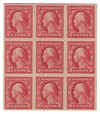
# 485 - 1916-17 5c Washington Imperforate Carmine Error
Just 50 of These Rare Errors Exist!
This mint block of nine stamps is a very rare error – only 50 were produced and Mystic has one of them. Look at the illustration – there’s a five-cent stamp (#485) surrounded by eight two-cent stamps (#482)!
How did a 5¢ stamp find its way onto a 2¢ stamp sheet?
This story begins in 1917, during the height of World War I, with an overworked and understaffed Bureau of Engraving and Printing struggling to keep up with war-time demands. An inspector at the Bureau proofed a sheet printed by plate 7942 of the current 2¢ issue, Scott #463. Three of the impressions made by the plate were found to be unsatisfactory, and the inspector ordered them replaced.
To understand what happened next, it’s important to know how these plates were produced. First a design is engraved on steel. Proofs are taken from this engraving. Once these proofs are approved, the steel of the original engraving is hardened, and it becomes the “die”. A transfer press is then used to transfer the die’s impression onto a cylinder of soft steel, known as the “roll,” which is in turn hardened. This roll is then put in a “siderographer’s” transfer press, which again transfers this image into the steel plates that are used to print the stamps. In short, a die is used to make a roll, which is used to make the printing plates.
On plate 7942, the impressions for stamps 74 and 84 on the upper left pane of 100, and stamp 18 in the lower right pane were found to be defective. The worker who repaired these three impressions accidentally replaced the 2¢ designs with 5¢ designs. Considering that the “5” on the transfer roll is very similar to a reversed “2”, it’s not surprising this mistake was made.
Because of the great strain placed upon the overworked employees of the Bureau of Engraving and Printing, the proof sheet was not inspected again. Production continued, and the sheets were eventually distributed to Post Offices.
Soon blocks of twelve containing a vertical pair of 5¢ stamps (sometimes referred to as the “double error’) and blocks of nine containing a single 5¢ stamp (often referred to as the “single error”) began to appear. Although the Post Office recalled all the sheets bearing the plate number 7942, some had already been sold and put into circulation.
Only One Available
Now you have the chance to own this rare imperforate error block of nine in mint condition. The #485 stamp in the center even features never-hinged gum. Stamp expert Max G. Johl described the block as “one of the rarities of the 20th century” and he was right! Mystic only has one block, so order now to avoid disappointment.
Just 50 of These Rare Errors Exist!
This mint block of nine stamps is a very rare error – only 50 were produced and Mystic has one of them. Look at the illustration – there’s a five-cent stamp (#485) surrounded by eight two-cent stamps (#482)!
How did a 5¢ stamp find its way onto a 2¢ stamp sheet?
This story begins in 1917, during the height of World War I, with an overworked and understaffed Bureau of Engraving and Printing struggling to keep up with war-time demands. An inspector at the Bureau proofed a sheet printed by plate 7942 of the current 2¢ issue, Scott #463. Three of the impressions made by the plate were found to be unsatisfactory, and the inspector ordered them replaced.
To understand what happened next, it’s important to know how these plates were produced. First a design is engraved on steel. Proofs are taken from this engraving. Once these proofs are approved, the steel of the original engraving is hardened, and it becomes the “die”. A transfer press is then used to transfer the die’s impression onto a cylinder of soft steel, known as the “roll,” which is in turn hardened. This roll is then put in a “siderographer’s” transfer press, which again transfers this image into the steel plates that are used to print the stamps. In short, a die is used to make a roll, which is used to make the printing plates.
On plate 7942, the impressions for stamps 74 and 84 on the upper left pane of 100, and stamp 18 in the lower right pane were found to be defective. The worker who repaired these three impressions accidentally replaced the 2¢ designs with 5¢ designs. Considering that the “5” on the transfer roll is very similar to a reversed “2”, it’s not surprising this mistake was made.
Because of the great strain placed upon the overworked employees of the Bureau of Engraving and Printing, the proof sheet was not inspected again. Production continued, and the sheets were eventually distributed to Post Offices.
Soon blocks of twelve containing a vertical pair of 5¢ stamps (sometimes referred to as the “double error’) and blocks of nine containing a single 5¢ stamp (often referred to as the “single error”) began to appear. Although the Post Office recalled all the sheets bearing the plate number 7942, some had already been sold and put into circulation.
Only One Available
Now you have the chance to own this rare imperforate error block of nine in mint condition. The #485 stamp in the center even features never-hinged gum. Stamp expert Max G. Johl described the block as “one of the rarities of the 20th century” and he was right! Mystic only has one block, so order now to avoid disappointment.







